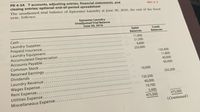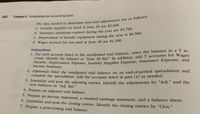
FINANCIAL ACCOUNTING
10th Edition
ISBN: 9781259964947
Author: Libby
Publisher: MCG
expand_more
expand_more
format_list_bulleted
Concept explainers
Question
thumb_up100%

Transcribed Image Text:### Educational Resource: Understanding the Unadjusted Trial Balance
#### PR 4-3A: T Accounts, Adjusting Entries, Financial Statements, and Closing Entries; Optional End-of-Period Spreadsheet
The unadjusted trial balance of Epicenter Laundry as of June 30, 2016, which is the end of the fiscal year, is given below. This trial balance lists all accounts with their respective debit and credit balances before any adjustments have been made for the final financial statements.
**Epicenter Laundry**
**Unadjusted Trial Balance**
**June 30, 2016**
| Account | Debit Balances | Credit Balances |
|----------------------------|----------------|-----------------|
| Cash | 11,000 | |
| Laundry Supplies | 21,500 | |
| Prepaid Insurance | 9,600 | |
| Laundry Equipment | 232,600 | |
| Accumulated Depreciation | | 125,400 |
| Accounts Payable | | 11,800 |
| Common Stock | 10,000 | 232,200 |
| Retained Earnings | | 40,000 |
| Dividends | 125,200 | |
| Laundry Revenue | | 65,600 |
| Wages Expense | 40,000 | |
| Rent Expense | 19,700 | |
| Utilities Expense | 5,400 | |
| Miscellaneous Expense | | |
| **Totals** | **475,000** | **475,000** |
**Explanation of Key Components:**
1. **Cash, Laundry Supplies, Prepaid Insurance, Laundry Equipment, Dividends, Wages Expense, Rent Expense, Utilities Expense:** These accounts show the resources that are available and the expenses incurred by the business during the fiscal period.
2. **Accumulated Depreciation, Accounts Payable, Common Stock, Retained Earnings, Laundry Revenue:** These accounts reflect long-term asset depreciation, liabilities, equity holdings, retained earnings, and revenue generated by the business.
3. **Balancing the Trial Balance:** The totals for debit (assets and expenses) and credit (liabilities, revenues, and equity) balances both equal 475,000. This balance confirms that the trial balance is

Transcribed Image Text:### Completing the Accounting Cycle
**The data needed to determine year-end adjustments are as follows:**
- **a.** Laundry supplies on hand at June 30 are \$3,600.
- **b.** Insurance premiums expired during the year are \$5,700.
- **c.** Depreciation of laundry equipment during the year is \$6,500.
- **d.** Wages accrued but not paid at June 30 are \$1,100.
#### Instructions
1. **For each account listed in the unadjusted trial balance, enter the balance in a T account. Identify the balance as “June 30 Bal.” In addition, add T accounts for Wages Payable, Depreciation Expense, Laundry Supplies Expense, Insurance Expense, and Income Summary.**
2. **(Optional)** Enter the unadjusted trial balance on an end-of-period spreadsheet and complete the spreadsheet. Add the accounts listed in part (1) as needed.
3. **Journalize and post the adjusting entries.** Identify the adjustments by “Adj.” and the new balances as “Adj. Bal.”
4. **Prepare an adjusted trial balance.**
5. **Prepare an income statement, a retained earnings statement, and a balance sheet.**
6. **Journalize and post the closing entries.** Identify the closing entries by “Clos.”
7. **Prepare a post-closing trial balance.**
Expert Solution
This question has been solved!
Explore an expertly crafted, step-by-step solution for a thorough understanding of key concepts.
This is a popular solution
Trending nowThis is a popular solution!
Step by stepSolved in 3 steps

Knowledge Booster
Learn more about
Need a deep-dive on the concept behind this application? Look no further. Learn more about this topic, accounting and related others by exploring similar questions and additional content below.Similar questions
- Required information Use the following information to answer questions. (Algo) [The following information applies to the questions displayed below.] The following information is available for ADT Company, which produces special-order security uses a job order costing system. Overhead is applied using a predetermined overhead rate of 5 labor cost. Beginning of period $ 45,000 9,600 68,000 End of Period $ 45,000 19,000 33,500 Inventories Raw materials Work in process Finished goods Cost incurred for the period Raw materials purchases Factory payroll Factory overhead (actual) Indirect materials used Indirect labor used Other overhead costs $ 178,000 250,000 9,000 57,500 115,500 Exercise 15-15 (Algo) Recording actual and applied overhead LO P3 1. Incurred other actual overhead costs (all paid in Cash). 2. Applied overhead to work in process. Prepare journal entries for the above transactions for the period. View transaction list Journal entry worksheet A В Record the entry for other actual…arrow_forwardA seller uses a perpetual inventory system, and on April 17, a customer returns $1,000 of merchandise previously purchased on credit on April 13. The seller's cost of the merchandise returned was $480. The merchandise is not defective and is restored to inventory. The seller has not yet received any cash from the customer.arrow_forwarda list of each customer account and thre balance owed is a:arrow_forward
- Create a schedule of accounts receivable using the accounts receivable subsidiary ledger‘s.arrow_forwardHello, can you help me with questions 7,8, and 9 please, thanks!arrow_forwardRequirements Sheet in Workbook Requirement 1—Prepare the Journal Entries in the General Journal Journal Entries Requirement 2—Post Journal Entries to the General Ledger General Ledger Requirement 3—Prepare a Trial Balance Trial Balance Requirement 4—Prepare the Adjusting Entries Adjusting Entries Requirement 5—Post Adjusting Entries to the General Ledger General Ledger Requirement 6—Prepare an Adjusted Trial Balance Adjusted Trial Balance Requirement 7—Prepare the Financial Statements Financial Statements Requirement 8—Prepare the Closing Entries Closing Entries Requirement 9—Post Closing Entries to the General Ledger General Ledger Requirement 10—Prepare the Post Closing Trial Balance Post-Closing Trial Balance During its first month of operation, the Quick Tax Corporation, which specializes in tax preparation, completed the following transactions. July 1 Began business by making a deposit in a company…arrow_forward
- Question Completion Status: QUESTION 2 Posting: transfers journal entries to ledger accounts. a. transfers ledger transaction data to the journal. Ob. is an optional step in the recording process. c. normally occurs before journalizing. d. QUESTION 3 Q5. All statement are limitations of trial balance Except: Click Save and Submit to save and submit. Click Save AlZ Answers to save all answers.arrow_forwardssignments x signment/assignmentOverview.do?filterMode=all&studentCourseSelector=199635 9 Cookie Graces Sady Teels Final Which of the following has the steps of the accounting cycle in the proper sequence? (Some Score steps may be missing.) Attempt a. analyze and record transactions, post transaction to the ledger prepare a trial balance, prepare financial statements, journalize closing entries, analyze adjustment data and prepare adjusting Score entries b. prepare financial statements, journalize closing entries and post to the ledger, analyze and record transactions, post transactions to the ledger, prepare a trial balance, analyze adjustment data, prepare adjusting entries C. prepare a trial balance, analyze adjustment data, prepare adjusting entries, prepare financial statements, journalize closing entries and post to the ledger analyze and record transactions, post transactions to the ledger Commen d. analyze and record transactions, post transactions to the ledger, prepare a…arrow_forwardJoint Cost Allocation—Market Value at Split-off Method Sugar Sweetheart, Inc., jointly produces raw sugar, granulated sugar, and caster sugar. After the split-off point, raw sugar is immediately sold for $0.20 per pound, while granulated and caster sugar are processed further. The market value of the granulated sugar and caster sugar is estimated to both be $0.25 at the split-off point. One batch of joint production costs $1,640 and yields 3,000 pounds of raw sugar, 3,600 pounds of granulated sugar, and 2,000 pounds of caster sugar at the split-off point. Allocate the joint costs of production to each product using the market value at split-off method. Joint Product Allocation Raw sugar $fill in the blank 1 Granulated sugar fill in the blank 2 Caster sugar fill in the blank 3 Totals $fill in the blank 4arrow_forward
arrow_back_ios
arrow_forward_ios
Recommended textbooks for you

 AccountingAccountingISBN:9781337272094Author:WARREN, Carl S., Reeve, James M., Duchac, Jonathan E.Publisher:Cengage Learning,
AccountingAccountingISBN:9781337272094Author:WARREN, Carl S., Reeve, James M., Duchac, Jonathan E.Publisher:Cengage Learning, Accounting Information SystemsAccountingISBN:9781337619202Author:Hall, James A.Publisher:Cengage Learning,
Accounting Information SystemsAccountingISBN:9781337619202Author:Hall, James A.Publisher:Cengage Learning, Horngren's Cost Accounting: A Managerial Emphasis...AccountingISBN:9780134475585Author:Srikant M. Datar, Madhav V. RajanPublisher:PEARSON
Horngren's Cost Accounting: A Managerial Emphasis...AccountingISBN:9780134475585Author:Srikant M. Datar, Madhav V. RajanPublisher:PEARSON Intermediate AccountingAccountingISBN:9781259722660Author:J. David Spiceland, Mark W. Nelson, Wayne M ThomasPublisher:McGraw-Hill Education
Intermediate AccountingAccountingISBN:9781259722660Author:J. David Spiceland, Mark W. Nelson, Wayne M ThomasPublisher:McGraw-Hill Education Financial and Managerial AccountingAccountingISBN:9781259726705Author:John J Wild, Ken W. Shaw, Barbara Chiappetta Fundamental Accounting PrinciplesPublisher:McGraw-Hill Education
Financial and Managerial AccountingAccountingISBN:9781259726705Author:John J Wild, Ken W. Shaw, Barbara Chiappetta Fundamental Accounting PrinciplesPublisher:McGraw-Hill Education


Accounting
Accounting
ISBN:9781337272094
Author:WARREN, Carl S., Reeve, James M., Duchac, Jonathan E.
Publisher:Cengage Learning,

Accounting Information Systems
Accounting
ISBN:9781337619202
Author:Hall, James A.
Publisher:Cengage Learning,

Horngren's Cost Accounting: A Managerial Emphasis...
Accounting
ISBN:9780134475585
Author:Srikant M. Datar, Madhav V. Rajan
Publisher:PEARSON

Intermediate Accounting
Accounting
ISBN:9781259722660
Author:J. David Spiceland, Mark W. Nelson, Wayne M Thomas
Publisher:McGraw-Hill Education

Financial and Managerial Accounting
Accounting
ISBN:9781259726705
Author:John J Wild, Ken W. Shaw, Barbara Chiappetta Fundamental Accounting Principles
Publisher:McGraw-Hill Education